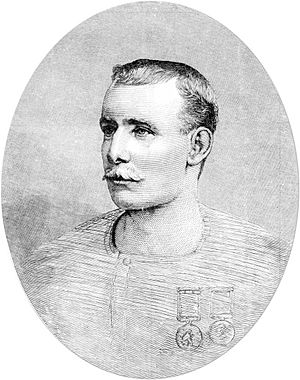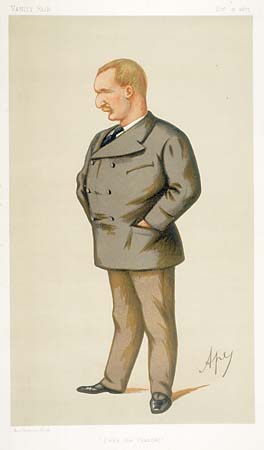Matthew Webb facts for kids
Quick facts for kids
Matthew Webb
|
|
|---|---|

Webb in 1883
|
|
| Born | 19 January 1848 |
| Died | 24 July 1883 (aged 35) |
| Resting place | Oakwood Cemetery, Niagara Falls, New York |
| Known for | Swimming the English Channel |
Captain Matthew Webb (born January 19, 1848 – died July 24, 1883) was a famous English swimmer. He was the very first person to swim across the English Channel just for sport. He did this without any special equipment to help him float. In 1875, Webb swam from Dover in England to Calais in France. It took him less than 22 hours! This amazing swim made him a huge star. He then did many exciting swimming stunts for people to watch. Sadly, he died trying to swim through the dangerous Whirlpool Rapids near Niagara Falls. People said this swim was impossible.
Contents
Early Life and Brave Rescues
Matthew Webb was born in Dawley, Shropshire, England. He was one of fourteen children. His family moved to Coalbrookdale when he was young. This is where he learned to swim in the River Severn.
When he was 12, in 1860, he joined a training ship called HMS Conway. He trained there for two years. After that, he joined the merchant navy. This meant he worked on ships that carried goods around the world.
A Hero at Sea
Once, while working on a ship called Russia, Webb showed great bravery. The ship was traveling from New York to Liverpool. A man fell overboard in the middle of the Atlantic Ocean. Webb bravely dived into the cold sea to try and save him.
Even though the man was never found, Webb's daring act made him famous. He received £100 and the first Stanhope Medal. The British newspapers called him a hero. Later, in 1863, he also saved his 12-year-old brother, Thomas, from drowning in the River Severn.
Swimming the English Channel
In 1873, Webb was a captain on a steamship. He read about someone who tried and failed to swim the English Channel. This inspired him to try it himself! He quit his job to focus on training.
He first trained in swimming pools. Then he moved to colder waters like the River Thames and the English Channel. His early training was helped by Fred Beckwith. Beckwith even organized a public swim in the River Thames. Webb swam almost 10 kilometers (6 miles). But not many people came to watch, so Beckwith lost money. Webb then found a new manager.
The Historic Swim
On August 12, 1875, Webb tried to swim the Channel for the first time. But strong winds and bad sea conditions made him stop. He didn't give up!
On August 24, he started his second attempt. He dived into the water from the Admiralty Pier in Dover. Three escort boats went with him. He had porpoise oil on his body to help keep him warm. He swam with a steady breaststroke.
He faced many challenges during the swim. He was stung by jellyfish. Strong currents near Cap Gris Nez pushed him off course. This kept him from reaching the shore for five hours. Finally, after about 21 hours and 40 minutes, he landed near Calais, France. He was the first person to successfully swim the English Channel! His path was not straight, covering almost 66 kilometers (40 miles).
He was the first to do it without any special help. In June 1875, an American named Paul Boyton had swum across. But Boyton wore a special inflatable suit.
Life After the Channel Swim
After his amazing swim, Matthew Webb became very popular. People all over the world admired him. He became a professional swimmer. He even wrote a book called The Art of Swimming. His name was used for products like special pottery and a brand of matches.
He performed many swimming shows and stunts. One time, he floated in a tank of water for 128 hours!
Championships and Family Life
In May 1879, Webb won the swimming Championship of England. He swam for fourteen hours a day for six days, covering 74 miles. In September 1879, he competed against Paul Boyton for the Championship of the World. Webb won, but there were arguments about cheating, so he didn't get the prize money.
On April 27, 1880, Matthew Webb married Madeline Kate Chaddock. They had two children, a son named Matthew and a daughter named Helen.
Tragic End at Niagara Falls
Matthew Webb was always looking for new challenges. He decided to try and swim the dangerous Whirlpool Rapids below Niagara Falls. Many people said this was an impossible swim.
He had trouble getting money to support this event. But on July 24, 1883, he jumped into the river. He started his swim near the Niagara Falls Suspension Bridge. Reports from that time suggest he made it through the first part of the swim. However, he likely died in the part of the river near the entrance to the whirlpool. Matthew Webb was buried in Oakwood Cemetery in Niagara Falls, New York.
Lasting Legacy
Matthew Webb is still remembered today for his incredible achievements.
Memorials and Tributes
In 1909, Webb's older brother, Thomas, unveiled a memorial in Dawley. It has a short but powerful message: "Nothing great is easy." This memorial was damaged in 2009 but was fully repaired and put back in place. Two roads in Dawley, Captain Webb Drive and Webb Crescent, are named after him. The Captain Webb Primary School in Dawley also carries his name.
There is a statue of Webb in Dover. A special plaque with his picture is in the church at Coalbrookdale. Webb House at the Adams' Grammar School in Newport, Shropshire, is also named after him.
Family Continues the Spirit
A book about Webb's life, called "Nothing Great Is Easy," was written in 1986. It tells the story of the first man to swim the English Channel.
Matthew Webb's great-nephew, Edward Webb, also achieved something amazing. On September 12, 1992, he became the first person to paraglide solo across the English Channel. This was 117 years after his great-uncle's famous swim. Edward was only 20 years old. His flight helped raise a lot of money for charity.
See also
- List of members of the International Swimming Hall of Fame
- List of successful English Channel swimmers
 In Spanish: Matthew Webb para niños
In Spanish: Matthew Webb para niños


